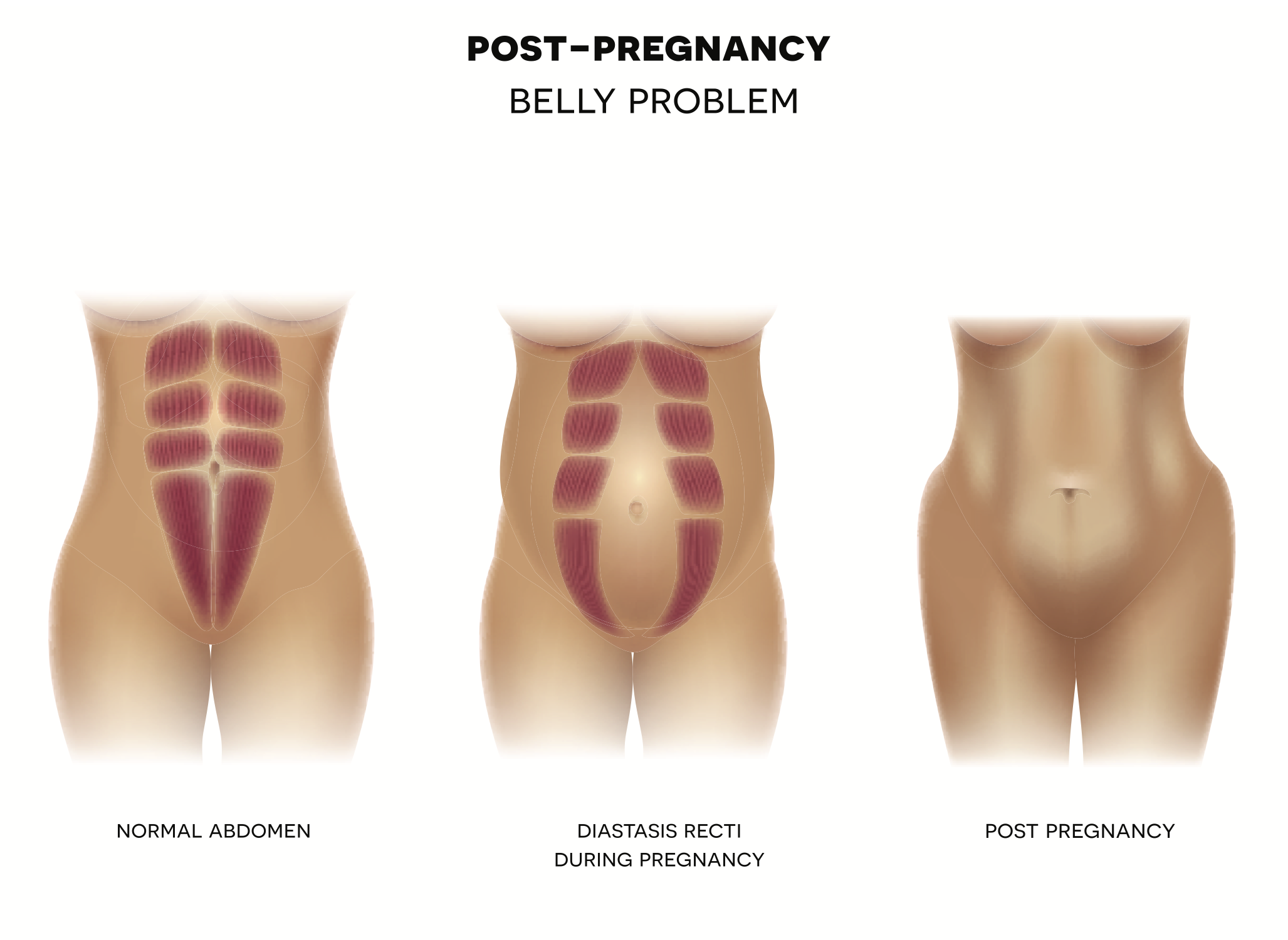Diastasis Recti: Diagnosis, Symptoms, Causes, and Repair
What is Diastasis Recti
Diastasis Recti (Rectus Abdominis Diastasis, RAD) is a condition in which the two Abdominal Muscles (Rectus) are separated to an abnormal degree. This causes the belly to stick out because of the widened space between the muscles. The distance in which is deemed ‘abnormal’ is measured at the belly button and is a distance of 2 cm or more. It is commonly caused by pregnancy, especially after carrying a large fetus or twins but it can also occur in middle-aged to elderly women who are overweight.
Protruding midline with an Intraabdominal pressure increased, Linea Alba widening, gradual thinning of the skin, and ventral abdominal muscle laxity are also characterized by abdominal separation.
The condition can generally be treated with Pelvic Floor Physiotherapy but if a midline hernia develops then surgical treatment will be required to cure.
Diastasis Recti Test
We can Self check for the Diastasis Recti by lying on our back and feeling between the abdominal muscle separation around the belly button area. If you notice any separation or depression between the muscles around it that exceeds 2.7 cm at the belly button level or if a cone-shaped bulge appears between the abdominals, you may have a Diastasis Recti. Follow the steps below for self-examination:
Place the fingers on the belly button.
Point the head of your fingers towards the pelvis side.
Press it down.
Lift your head about an inch or two, keeping the shoulders down on the floor.
If you feel a gap of more than one finger in width, you may have Diastasis Recti.
Symptoms of Diastasis Recti'
Diastasis is most common in Females after Pregnancy or Postpartum. It is generally not experienced in the first half of the pregnancy but is often noticed at the end of the second or third Trimester. Many mothers do not notice it until after delivery.
Pain and urinary incontinence are the most common symptoms after having diastasis recti. Other symptoms include:
The abs near the belly button are contracted and engaged
Difficulty in lifting objects
Lower Back Pain
Poor Posture
Urinary Incontinence
Weakened abdominal Muscles
Difficulty in performing routine DLA's
Postpartum Abdominal Separation
The amount of the separation caused by Diastasis Recti can vary. It usually happens when the uterus exerts pressure on the muscles and drives it apart, making them weaker and longer. Often the separations between the stomach muscles get back to normal when the baby gets 8 weeks old but for many it takes much longer.
Causes of Diastasis Recti for People Who Are Not Pregnant or Postpartum
Studies show that 60% of the females suffer from Diastasis Recti during or after pregnancy. However, it is not limited to the females of postpartum only. Abdominal separation can affect anyone including men or newborn babies. Most common causes are heavy weight lifting, excessive exercise, unsafe abs-based workouts, or bad postures. Women over the age of 35 who have historically delivered multiples or large babies or those who excessively exercised their abdominal muscles while pregnant have a higher chance of experiencing Diastasis Recti.
Why It’s Important to Treat Diastasis Recti
Separated abdominal muscles cannot perform optimally and over time, this weakened support from ones core can cause other related issues such as back pain and poor posture. In addition, you cannot effectively strengthen your core muscles without first getting them into the correct alignment. Inner core muscle strength is essential for balance, lifting, exercise, and essential for pelvic floor contraction. 70% of women cannot perform a pelvic floor contraction if suffering from Diastasis Recti and these contractions are a key way to support pelvic floor health associated with bladder, bowel, and sexual function.
How to Naturally Treat Diastasis Recti
Natural Diastasis Recti treatment focuses on Physiotherapy for rehabilitation. Although some work can be done at home, working a practitioner is recommended to ensure that the separation doesn’t get worse.
The abdominal muscles require rebuilding from the transverse abdominals (TVA), the inner muscles that can provide deep core strengthening and support for the muscles that have been stretched. Working on diaphragmatic breathing to pull the muscles inwards and Pelvic Floor Muscle exercises like kegels are effective. Heel Slides, Abdominal compressions, Toe Taps, Pelvic Tilts, Bridge Poses, Belly Scooping, Single-Leg Stretches can all help with safe strengthening. These exercises will also help reduce the symptoms that occur as a result of Diastasis Recti such as incontinence. Pilates and programs tailored at gentle postpartum healing like The Barre Method with instructor modifications and guidance can be helpful at improving abdominal separation.
What to Avoid When You Have Diastasis Recti
Avoid heavy weight lifting, sit-ups or crunches, full planks, or any exercises where your abdominals are bulging. Backbends and other spinal extensions put stress on the abdominal muscles and should be avoided.
How to Prevent Diastasis Recti in pregnancy or any time
If you're trying to get pregnant, including exercises to strengthen the abdominal muscles in your regular exercise routine. Strengthening your core muscles before you get pregnant or in the early stages of pregnancy might help prevent abdominal separation. It's best to avoid putting excess strain on your abdominal muscles while pregnant. Avoid sit-ups or planks. Try to avoid constipation and if you have a cough, get it treated.
If you are already expecting and don't have Diastasis Recti, try pregnancy-safe exercises (as long as you have your practitioner's okay).
Does Diastasis Recti heal on its own?
Approximately 50% of the women having Diastasis Recti, have it resolved within 6 months. But most of the experts think that exercises, weight loss, and physiotherapy play a vital role in treating the condition.
Diastasis Recti Surgery
Doctors cannot yet agree of what will necessitates surgery for Diastasis Recti. However, some people who have exhausted natural treatments like Physiotherapy and Pelvic Floor strengthening and continue to experience pain or other symptoms might consider surgery. Some patients undergo surgery for cosmetic reasons - to reduce their stomach bulge. The procedure is an abdominoplasty to bring the muscles together and this is performed alongside a tummy tuck to remove the excess fat and skin. It is recommended that you do not consider surgery until you are finished having children, have waiting one year since your last birth, and have exhausted other natural treatment options like Physiotherapy.
Want a Free Pelvic Consultation?
Quality Care Practitioners are offering free pelvic consultations before you book an assessment.
Make it stand out
Meet a Quality Care Pelvic Physiotherapist to be assessed and treated for Diastasis Recti.
Virtual Pelvic Support On-Demand
Want to submit a question and get a personalized video answer back? We have partnered with Wellby where you can ask their Pelvic specialists questions online and skip the appointment altogether. It’s free to join and their women’s health experts are curated from around the world and seen in publications including Cosmopolitan, Women’s Health Magazine, Elle, and more.




